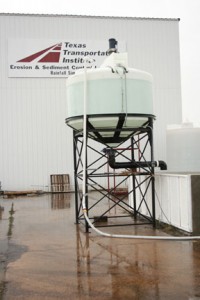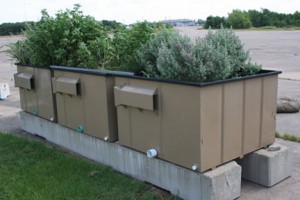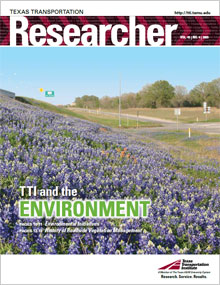
It’s every kid’s dream — that playing in dirt could make you cleaner than the dreaded bath time. But one Texas Transportation Institute (TTI) project is using soil and plants together to clean storm water runoff before it returns to the main water supply. As storm water washes down an embankment, it carries with it an assortment of pollutants and pathogens.
Water contamination is a concern for every urban area, especially areas with an aquifer. Bioretention is one low-impact development technique advocated by the U.S. Environmental Protection Agency to clean storm water runoff — a water quantity and quality control system that consists of a water storage space, vegetation, mulch, soil and gravel.
“Bioretention removes pollutants from runoff via physical, chemical and biological processes,” explains Ming-Han Li, an assistant research engineer for TTI, who is leading the bioretention research. “The various layers of vegetation, soil and gravel act as a filter for dirty water.”
In bioretention facilities, runoff from parking lots or pavements is detained on top and filters through the soil, undergoing constant cleaning until it reaches the discharge point. Plant roots take out pollutants such as nitrogen and phosphorus, while soil absorbs metals such as zinc and lead and pathogens such as E. coli. Determining the ideal configuration is complex, however.

While plants’ roots are necessary for pollutant removal, they also decrease the detention time. Li’s current task is to determine how to optimize performance between roots and detention time — as well as combating fire ants, whose elaborate tunnels become an expressway for water. The research team plans to monitor two field demonstration sites to better understand bioretention’s real-world performance.
“We are working toward a method that utilizes the properties of plants and soil microbial action to remove pollutants, requires only periodic maintenance and is aesthetically pleasing to the public,” says Steve Ligon, an environmental specialist in the Texas Department of Transportation (TxDOT) Environmental Affairs Division. Ligon is working with Li and TTI‘s Environmental Management Program on the project.
Initial studies in other parts of the country produced promising results with bioretention, but can the same methods be successful given Texas’ unique and varied climate? Li, who is both an engineer and a landscape architect, knew that the right plants for this substantial job would not only need to be native to the specific Texas region but also be able to survive periods of drought. TTI‘s team tested vegetation in small-scale experiments with controlled soil and water content. They discovered that the longer the water was detained in the soil, the cleaner it came out in the discharge.
“This research bridges disciplinary gaps. We’re connecting several concepts together in the beginning stages, combining engineering disciplines to create aesthetically pleasing, environmentally conscious and functional designs to maintain TxDOT‘s rights-of-way,” says Li. “TxDOT‘s effort in researching new designs of storm water from Texas highways is over and beyond the call of duty.”
